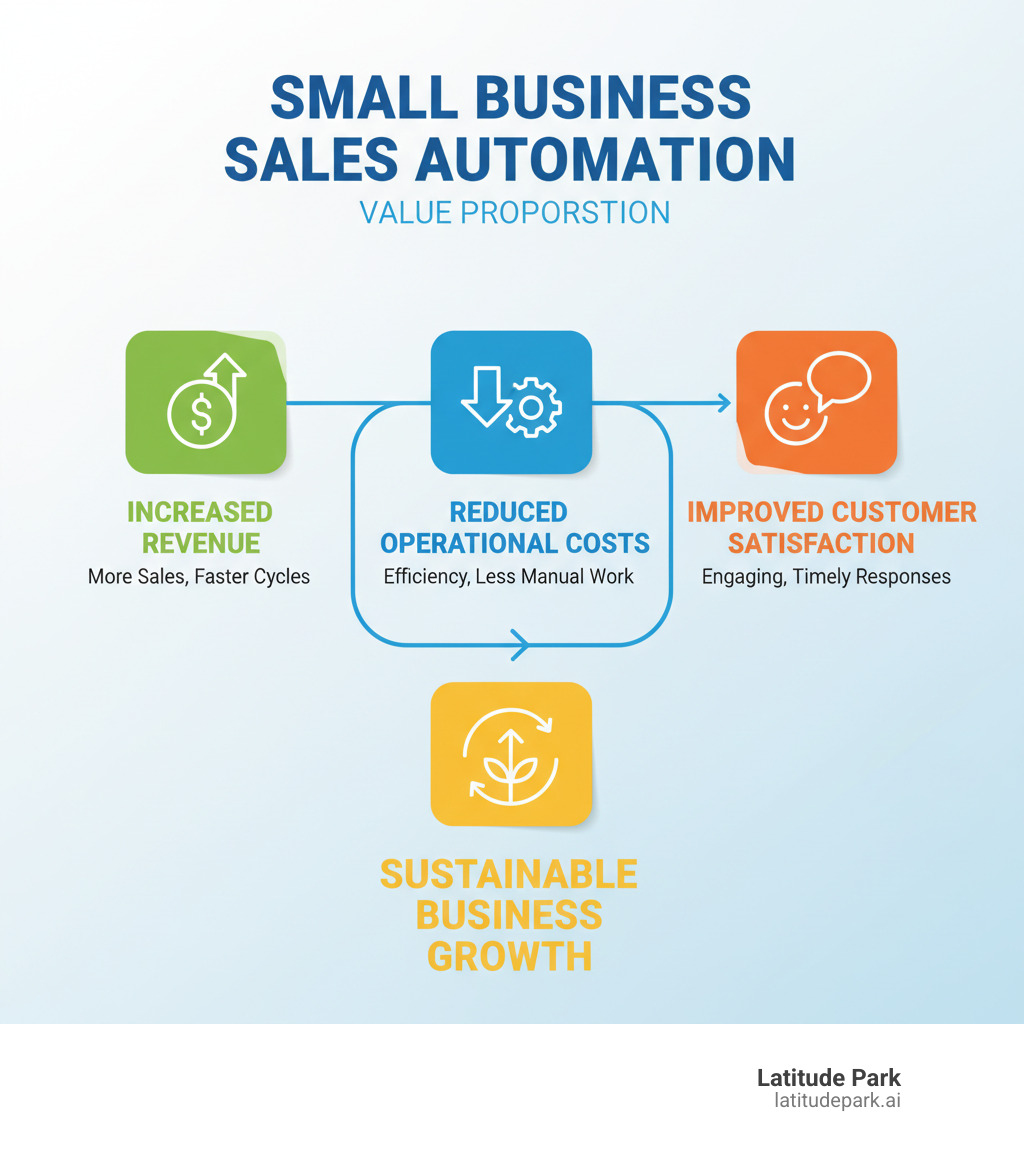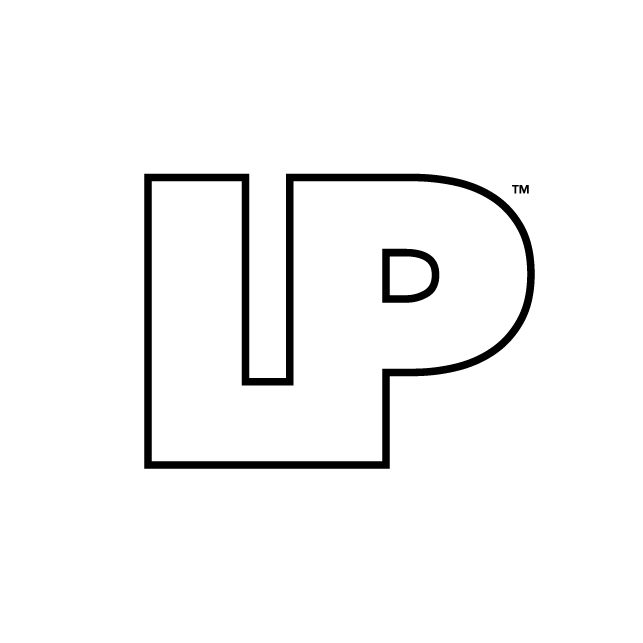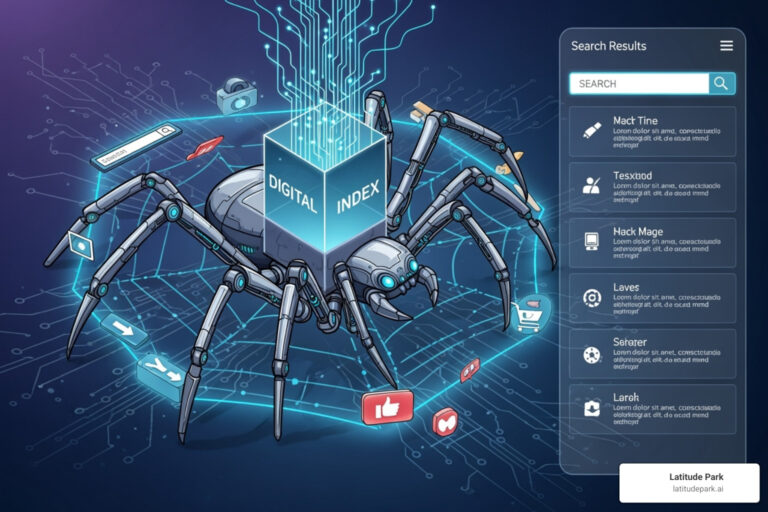Why Small Business Sales Automation is Your Key to More Revenue and Less Stress
Small business sales automation uses technology to handle repetitive sales tasks automatically, freeing up your team to focus on closing deals and building relationships. Here’s what you need to know:
Core Benefits:
- Save 10-16 hours per week on repetitive tasks
- Never miss a lead with automated follow-ups
- Respond faster to prospects (within minutes, not hours)
- Scale your sales without hiring more staff
- Get better data on what’s working
Most Important Tasks to Automate First:
- Lead follow-up emails and texts
- Appointment scheduling
- Lead scoring and assignment
- Welcome email sequences
- Data entry and activity logging
The numbers don’t lie. According to research, the average entrepreneur dedicates up to 16 hours weekly to repetitive processes. That’s nearly half your work week spent on tasks a computer could handle better and faster.
Sales automation isn’t about replacing your sales team – it’s about making them superhuman. When your CRM automatically captures leads, sends follow-ups, and schedules meetings, your salespeople can spend their time doing what humans do best: building trust and closing deals.
I’m Rusty Rich, President and founder of Latitude Park, where I’ve helped hundreds of small businesses and franchises implement small business sales automation strategies that drive measurable growth since 2009. Through our work with multi-location businesses, I’ve seen how the right automation tools can transform a chaotic sales process into a predictable revenue engine.
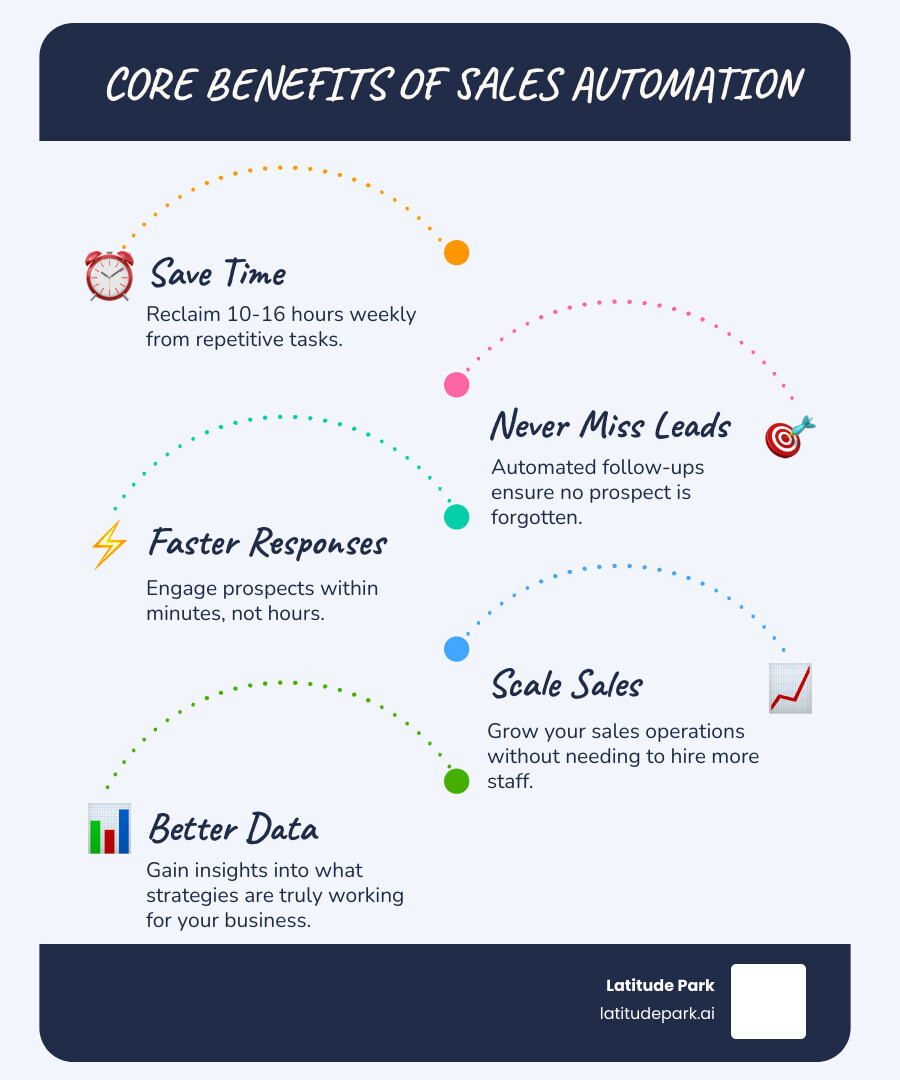
25 Actionable Sales Automation Ideas to Implement Today
Running a small business means wearing a dozen different hats – and keeping track of every lead, follow-up, and sales task can feel overwhelming. That’s where small business sales automation becomes your secret weapon, changing scattered efforts into a streamlined system that works around the clock.
These 25 automation ideas aren’t just theory – they’re practical solutions you can start implementing today. I’ve seen businesses go from drowning in manual tasks to running like well-oiled machines, simply by automating the right processes at the right time.
Automating Lead Capture and Management (Ideas 1-7)
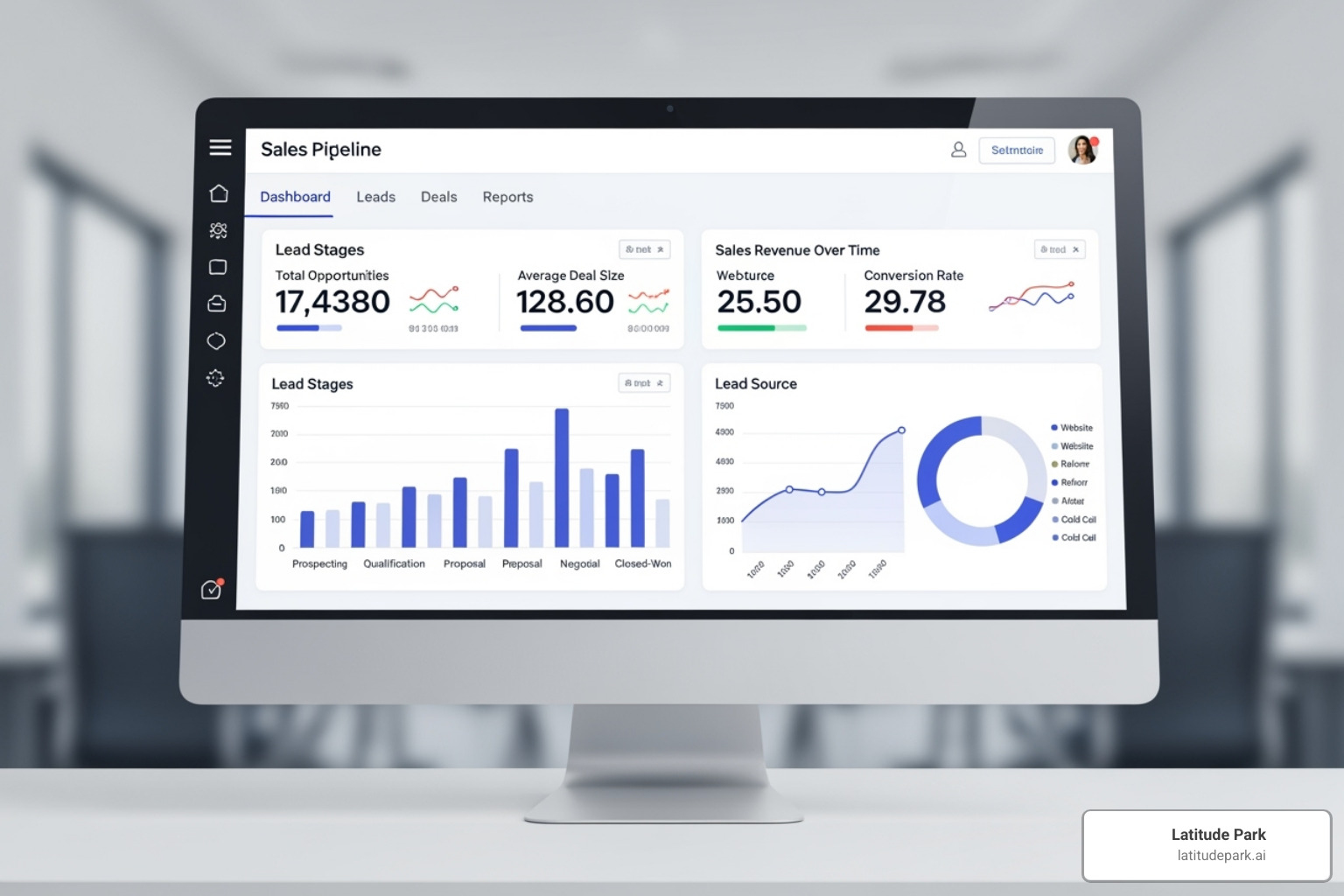
Think of lead capture as the front door to your business. When someone shows interest, you need to grab that opportunity instantly – not when you remember to check your inbox three hours later.
Automated web form entry is your first line of defense against lost leads. Every time someone fills out a contact form on your website, the information flows directly into your CRM without you lifting a finger. No more sticky notes or forgotten emails buried in your inbox.
Social media lead capture works similarly but pulls interested prospects from your Facebook ads or LinkedIn campaigns straight into your sales pipeline. This is especially powerful for businesses running targeted social media campaigns – every click becomes a trackable opportunity.
Lead scoring takes the guesswork out of prioritizing prospects. The system automatically assigns points based on actions like website visits, email opens, and demographics. A prospect who visited your pricing page three times and downloaded your brochure obviously deserves more attention than someone who just signed up for your newsletter.
Automatic lead assignment ensures your best leads don’t sit in limbo. Whether you use round-robin distribution to balance workloads or assign leads based on territory or expertise, automation makes sure someone takes ownership immediately.
Lead segmentation groups similar prospects together automatically. Your software startup leads get different messaging than your restaurant franchise inquiries – and automation handles this sorting without manual intervention.
“Missed call text back” automation is a game-changer for service businesses. Miss a call? The system immediately sends a text acknowledging the attempt and offering alternative ways to connect or book an appointment.
Finally, automated data enrichment fills in the blanks about your leads by pulling public information, while database reactivation campaigns breathe new life into old contacts who might be ready to buy now.
Streamlining Sales Communication and Nurturing (Ideas 8-15)
Once you’ve captured leads, consistent follow-up separates successful businesses from those that struggle. But “consistent” doesn’t mean you need to manually craft every email at 6 AM.
Automated welcome email series make incredible first impressions. New leads receive a professionally crafted sequence introducing your company, setting expectations, and providing immediate value – all while you’re sleeping or focusing on other priorities.
Drip marketing campaigns nurture leads over weeks or months with perfectly timed, relevant content. Think of it as having a patient, knowledgeable salesperson who never forgets to follow up and always knows exactly what to say.
Personalized follow-up reminders ensure nothing falls through the cracks. Your CRM can automatically remind you to call a hot prospect or trigger an email when someone hasn’t responded in a week. It’s like having a personal assistant who never takes a day off.
Automated appointment scheduling eliminates phone tag forever. Prospects can book available time slots directly from your calendar, reducing friction and increasing show rates. No more “When works for you?” email chains that drag on for days.
AI-powered email writing assistants help craft compelling messages faster. These tools suggest subject lines, adjust tone for different audiences, and even help overcome writer’s block when you’re staring at a blank email.
Automated SMS follow-ups cut through inbox clutter. A well-timed text reminder about an upcoming appointment or a quick check-in after sending a proposal often gets faster responses than email.
Website chatbots capture leads 24/7, answering common questions and collecting contact information even when your office is closed. They’re like having a friendly receptionist who never needs a lunch break.
These lead nurturing best practices work together to build relationships systematically, ensuring prospects receive the right message at the right time in their buying journey.
Automating the Deal Closing and Onboarding Process (Ideas 16-20)
The final stretch of closing deals is where many businesses fumble – not because they can’t sell, but because administrative tasks slow everything down. Automation keeps momentum going when prospects are ready to buy.
Automated proposal generation transforms hours of work into minutes. Pull client information, product details, and pricing from your CRM to create professional, personalized proposals instantly. Your prospects get faster responses, and you get more time to sell.
Automated contract sending with e-signature integration eliminates printing, scanning, and mailing delays. Contracts arrive in inboxes immediately, get signed digitally, and return to you for processing – all tracked automatically.
Automated invoicing and payment reminders improve cash flow dramatically. Generate invoices the moment deals close, then send gentle reminders at predetermined intervals. Late payments decrease when the system handles follow-up consistently.
Predictive dialers maximize efficiency for call-heavy sales processes. The system automatically dials numbers, filters out busy signals and voicemails, and connects you only to live prospects. More conversations equal more closed deals.
Automated new customer onboarding starts relationships on the right foot. Welcome emails, training materials, setup instructions, and check-in calls happen automatically, ensuring new clients feel supported from day one.
Enhancing Post-Sale and Reporting Activities (Ideas 21-25)
The sale isn’t the end – it’s the beginning of a relationship that can generate referrals, repeat business, and valuable insights for improvement.
Automated customer feedback requests and review generation happen at optimal times after purchase or service delivery. Happy customers are more likely to leave positive reviews when asked at the right moment, and you’ll catch potential issues before they become bigger problems.
Automated referral program invitations turn satisfied customers into your sales force. The system identifies your happiest clients and automatically invites them to refer others, often with incentives that benefit both parties.
Automated sales activity logging captures every call, email, and meeting automatically. Your CRM maintains comprehensive interaction histories without manual data entry, giving you complete visibility into what’s working.
Real-time sales performance dashboards provide instant visibility into pipeline value, conversion rates, and individual performance. Make data-driven decisions quickly instead of waiting for monthly reports.
Automated sales forecasting reports predict future revenue based on current pipeline status, historical data, and lead scoring. Plan resources effectively and make strategic decisions with confidence.
These 25 automation ideas work best when implemented gradually, starting with your biggest pain points. At Latitude Park, we’ve seen how systematic approaches to automation – whether in sales processes or advertising campaigns – create sustainable growth for businesses ready to scale efficiently.
The Power Trio: Sales Automation, Marketing Automation, and CRM

Here’s the thing about small business sales automation – it doesn’t work in isolation. Think of it as one gear in a well-oiled machine, working alongside marketing automation and your CRM system to create something much more powerful than any single tool could achieve alone.
Sales automation is your closer. It handles the nitty-gritty of moving prospects through your sales pipeline – automatically assigning leads to the right rep, sending follow-up reminders, generating proposals, and logging every interaction. Its main job is keeping your sales team focused on what they do best: building relationships and closing deals.
Marketing automation is your lead magnet and nurturer. While sales automation focuses on closing, marketing automation is all about attracting and warming up prospects. It sends targeted email campaigns, manages your social media content, segments your audience, and guides leads through those crucial early stages of the buying journey. Think of it as your 24/7 lead nurturing assistant.
The magic happens when these two work together seamlessly. Marketing automation handles the heavy lifting of lead nurturing – sending educational content, tracking engagement, and identifying when a prospect is ready to buy. Once that lead shows serious buying signals, small business sales automation takes the handoff and focuses on closing the deal.
But here’s where your CRM becomes absolutely critical – it’s the central nervous system that connects everything. Your CRM creates that essential 360-degree customer view by collecting and organizing data from both your marketing and sales activities. Without this central hub, you’d have marketing data living in one place and sales information scattered elsewhere, making personalization nearly impossible.
Data synchronization between these three systems ensures everyone’s working with the same, up-to-date information. When your marketing team sees that a lead downloaded three whitepapers and attended a webinar, and your sales rep knows about yesterday’s phone conversation, that’s when the real magic happens – truly personalized, effective customer interactions.
This integrated approach creates what we call a seamless customer journey. From that first social media interaction to the final contract signature and beyond, every touchpoint feels connected and purposeful. It’s this kind of strategic thinking that drives successful integrated digital strategies for growing businesses.
How to Choose and Implement Small Business Sales Automation
Choosing the right small business sales automation tools doesn’t have to feel overwhelming. Think of it like buying a new car – you wouldn’t walk onto the lot without knowing what you need, your budget, or how many people you need to seat.
Selecting the Right Small Business Sales Automation Tools
The key to successful automation starts with honest self-reflection about your business needs. Before you get impressd by flashy features or impressive demos, take a step back and examine your current sales process with fresh eyes.
Start by identifying your biggest bottlenecks. Where does your team spend the most time on repetitive tasks? Maybe it’s manually entering leads from web forms, or perhaps your salespeople are drowning in follow-up emails. One of my clients was spending three hours every Monday morning just sorting through weekend leads and assigning them to reps. That’s exactly the kind of pain point that automation solves beautifully.
Budget considerations are crucial, but think beyond the monthly fee. Yes, small business sales automation tools range from free plans with basic features to comprehensive platforms with per-user costs. However, the real question is return on investment. If a tool saves your team 10 hours per week and helps you close two additional deals per month, even a $200 monthly investment pays for itself many times over.
Ease of use can make or break your automation efforts. I’ve seen too many small businesses invest in powerful platforms that sit unused because they’re too complex. Your team needs to actually use the tools for them to work. Look for clean interfaces, intuitive navigation, and – this is important – responsive customer support. When you’re stuck at 8 PM trying to send a proposal, you want help available.
Scalability matters more than you might think. Your five-person team today might be fifteen people next year. Choose tools that can grow with you without requiring a complete overhaul. Many platforms offer tiered pricing that scales with your needs, which is perfect for growing businesses.
Integration capabilities are non-negotiable in today’s connected world. Your sales automation needs to talk to your email system, calendar, accounting software, and any other tools your business depends on. Disconnected systems create data silos and missed opportunities. Before committing to any platform, verify it integrates with your existing tech stack.
AI-powered features are becoming increasingly valuable for small businesses. From writing assistance that helps craft better emails to predictive analytics that identify your hottest prospects, AI in digital marketing and sales is leveling the playing field. These features can give you capabilities that were once only available to enterprise companies.
Best Practices for a Successful Small Business Sales Automation Rollout
Implementation success depends more on your approach than the tools themselves. I’ve seen businesses transform their sales results with basic automation, while others struggle despite having premium platforms.
Start small and focus on high-impact tasks first. Don’t try to automate your entire sales process on day one. Pick one or two repetitive tasks that consume significant time – like lead follow-ups or appointment scheduling – and automate those first. Quick wins build momentum and team confidence.
Document everything before you automate it. This might seem tedious, but mapping your current sales process reveals inefficiencies you didn’t know existed. You might find that leads are getting lost between marketing and sales, or that follow-up timing is inconsistent. Understanding these gaps helps you design better automated workflows.
Get your team on board early and often. Change can be scary, especially when people worry about being replaced by technology. Be transparent about why you’re implementing automation – to free them up for relationship building and strategic selling, not to eliminate jobs. Involve your team in selecting tools and designing workflows. Their buy-in is essential for success.
Maintain the human touch throughout your automated processes. While automation handles the repetitive tasks, your team’s personality and expertise are what close deals. Small business sales automation should improve human connections, not replace them. Automated emails should sound like they came from a real person, and there should always be easy ways for prospects to connect with your team directly.
Monitor, measure, and optimize continuously. Implementation isn’t a set-it-and-forget-it process. Track key metrics like response rates, conversion rates, and time savings. Use A/B testing to improve your automated emails and workflows. What works for one business might not work for yours, so be prepared to adjust based on real performance data.
The goal isn’t perfect automation from day one – it’s building a system that gets better over time while giving your team more time to focus on what they do best: building relationships and closing deals.
Frequently Asked Questions about Sales Automation
When I talk with small business owners about small business sales automation, I hear the same concerns and questions over and over. Let me address the big ones that might be on your mind too.
Does sales automation replace salespeople?
Here’s the thing that worries most business owners: “If I automate my sales process, will I need fewer people?” The short answer is no, and here’s why that’s actually great news.
Small business sales automation doesn’t replace your sales team – it makes them superhuman. Think of it like giving your best salesperson a really smart assistant who never sleeps, never forgets to follow up, and handles all the boring paperwork.
Your salespeople are still doing what they do best: building relationships, understanding customer problems, and closing deals. But now they’re not spending half their day on data entry, scheduling calls, or wondering if they remembered to follow up with that hot lead from last Tuesday.
The automation handles the repetitive stuff so your team can focus on the high-value activities that actually require human touch. Trust me, your customers still want to talk to real people when making important decisions. They just don’t want to wait three days for you to get back to them because you were buried in administrative tasks.
How much does sales automation software cost for a small business?
I get it – budget is always a concern for small businesses. The good news is that small business sales automation tools come in all price ranges, and you don’t need to break the bank to see real benefits.
Many platforms offer free plans that can get you started. These usually have limitations – maybe you can only have 100 contacts or send 50 emails per month – but they’re perfect for testing the waters. It’s like getting a free sample at the ice cream shop before you buy a whole cone.
Paid plans typically run $10 to $50 per user per month for most small businesses. Some all-in-one platforms that combine your CRM, email marketing, and sales automation might cost more upfront but can actually save money compared to buying separate tools.
Here’s how I tell my clients to think about it: if a tool saves you five hours a week, that’s probably worth $200+ in your time alone. Factor in the deals you won’t miss because of better follow-up, and most tools pay for themselves within the first month or two.
The key is focusing on return on investment rather than just the monthly fee. Even a $100-per-month tool is a bargain if it helps you close two extra deals.
What’s the first sales task a small business should automate?
This is probably the most practical question I get, and my answer is always the same: start with lead follow-up.
Most small businesses are terrible at following up consistently. A lead comes in, you get busy with other customers, and by the time you remember to reach out, they’ve already bought from someone else. Sound familiar?
Automated welcome emails and follow-up sequences solve this problem instantly. When someone fills out a form on your website or downloads your guide, they immediately get a friendly email thanking them and outlining next steps. No delays, no “I’ll get to it tomorrow,” no missed opportunities.
Appointment scheduling is my second recommendation. The back-and-forth of “How about Tuesday? No, I’m busy Tuesday. Wednesday? I have a conflict Wednesday morning…” drives everyone crazy. With automated scheduling, prospects can see your real availability and book directly into your calendar.
These two tasks are perfect starting points because they’re high-volume, repetitive, and crucial for customer experience. They give you quick wins that build confidence in the whole automation process, and they free up time for your team to focus on actually talking to prospects instead of playing email tag.
Conclusion: Automate to Accelerate Your Growth
The journey we’ve taken together through small business sales automation reveals a fundamental truth: automation isn’t about replacing the human element in sales – it’s about amplifying it. When you reclaim those 16 hours per week spent on repetitive tasks, you’re not just saving time. You’re creating space for what really matters: building genuine relationships with your customers and focusing on the strategic thinking that drives growth.
Think about where your business could be six months from now. Your leads are captured automatically, never falling through cracks. Your follow-up emails go out like clockwork, nurturing prospects while you sleep. Your sales team spends their days having meaningful conversations instead of wrestling with data entry and scheduling conflicts. This isn’t a fantasy – it’s the reality that small business sales automation creates.
The scalability factor alone makes automation essential for growing businesses. As your customer base expands, manual processes become bottlenecks that choke growth. Automation removes these constraints, allowing you to serve more customers with the same level of excellence, without proportionally increasing your overhead.
Your customers benefit too. They receive faster responses, more consistent communication, and a smoother overall experience. When buyers expect instant gratification, automation helps you meet and exceed those expectations every single time.
At Latitude Park, we’ve witnessed how targeted strategies transform businesses. Whether we’re helping franchises maximize their Meta advertising results or guiding companies toward smarter internal processes, the principle remains the same: the right systems create predictable, sustainable growth. Small business sales automation follows this exact blueprint – it’s a system that works for you, not against you.
The path forward is clear. Start with one high-impact automation – perhaps those crucial follow-up emails or appointment scheduling that’s eating up your day. Build confidence with early wins, then gradually expand your automated processes. Every manual task you automate is an investment in your business’s future capacity to grow.
Don’t let outdated processes hold your business back when the tools to accelerate your growth are readily available. Your competitors who accept automation will have a significant advantage in speed, consistency, and scalability.
Ready to take the next step? Explore our complete guide to Small Business Automation Tools to get started on your automation journey today.
